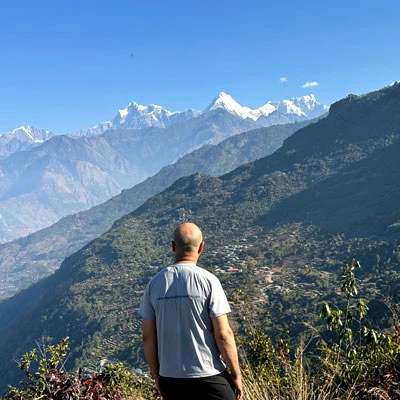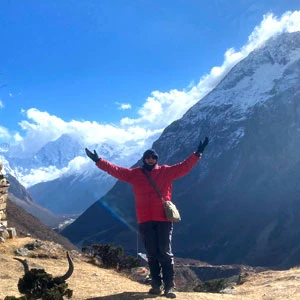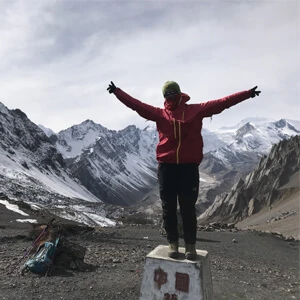Today, the Nar Phu Valley Trek provides an unparalleled experience with its best-kept routes, dramatic landscapes, rich culture, and biodiversity. Mesmerizing mountain vistas, remote villages, high passes, dense forests, massive glaciers, narrow canyons, ancient beliefs, and their practices day-to-day are what shape this journey.
Therefore, to enjoy and immerse yourself in this whole new experience, you will need to set your timing right as your journey will widely vary depending on the season you trek in. Each season adds its charm and beauty to this trek, significantly providing more or less enjoyment than you had imagined.
Indeed, the seasons have a huge impact on how your trek will further proceed hence, choosing the right time is essential. Additionally, the favorable season brings much fewer complications when you ascend to higher altitudes.
However, having said that each trekker has their own preferences when it comes to trekking criteria. Some may think of thrill and adventure while trekking to the foothills of those majestic mountains, while some may seek peace and comfort in a similar situation.
Here is the complete guide to Nar Phu Valley Trek, we will break down and explore each season to find the best time to undertake this remarkable trek.
Seasons For The Nar Phu Valley Trekking
The Nar Phu Valley Trek takes you to a maximum altitude of 5,320 meters / 17,454 feet at the Kang La Pass. Often the weather starts to get unpredictable above 2000 meters varying as per the seasons.
Now, Nepal has four primary seasons; Spring, Summer / Monsoon, Autumn, and Winter. For Nar Phu Valley Trek, we recommend you embark on this journey during Spring (March to May) and Autumn (September to November) due to their favorable conditions.
Spring (March, April, And May)
It is one of the ideal seasons to embark on the Nar Phu Valley Trek. It is the season of rebirth that paints the whole Nar Phu Valley in vibrant colors. After February, as the winter chill starts to fade, Spring starts from March.
During March, the air is cool with the mix of remaining winter chills. Slowly, you will witness new growth in the trees with many buds on flowering plants. As you move on to April, the temperature gets moderate with the fresh smell of the flowers that will be blooming all around. Soon, the valley revives with lush greenery. Likewise, May starts to get a bit warmer marking the end of the season.
Overall, the Spring season maintains a pleasant surrounding with cool temperatures, beautiful scent in the air, lush greenery, and fully bloomed seasonal flowers. Furthermore, the high daytime temperature during this season can reach between 10°C to 20°C while the nighttime temperature can drop up to -5°C to 5°C at higher altitudes. Not to mention, the temperature can go as low as -15°C at the beginning of Spring.
Pros of Trekking In Spring
- Vibrant full blooms of flowers such as rhododendrons and magnolia.
- Higher chance of coming across wildlife such as Himalayan black bears, Himalayan Tahr, Himalayan griffon, Himalayan monal, Musk deer, bearded vultures, and so on.
- Incredible photo opportunities as vibrant flowers contrast the snowy peaks.
- Moderate temperature with a fresh breeze.
- More accessible and dry trail.
- Cheaper cost of special permit.
Cons of Trekking In Spring
- More crowds than usual leading to busy trails.
- Hassle in booking accommodation or transportation facilities.
- Rare cases of snowfall and winter chills during the beginning of March.
- Occasional rain showers and hazy weather during the end of May.
Tips For Spring Trek
- Book your plan for Nar Phu Valley Trek in advance with a reputable and authorized trekking company.
- Pack light! Dress up in layers to adjust to sudden weather changes.
- Carry rain gear to prepare for occasional rain showers, especially if you are traveling during the end of May.
Autumn (September, October, And November)
Another peak season for the Nar Phu Valley Trek, Autumn is also known as the season with pinnacle beauty. As it is a post-monsoon season, it boasts clarity in the surroundings offering stable weather conditions.
During this season, the valley has a picturesque landscape with clear blue skies and a crisp atmosphere. Additionally, since the monsoon clouds are cleared, it presents a cool and dry route eliminating any natural incidents.
Moving on, the Autumn temperature is quite comfortable. Usually, the daytime temperature ranges from 10°C to 20°C however, the nights are much colder with the temperature running in between -10°C to 0°C.
Pros of Trekking In Autumn
- Stable weather conditions with crystal clear blue skies and no hindrance to the surrounding scenery.
- A fresh and cool breeze creates a comfortable environment.
- Incredible photo opportunities with mesmerizing views of the snow-capped peaks.
- Dry and easy trail.
- Opportunity to witness the major celebration of Dashain and Tihar.
Cons of Trekking In Autumn
- More crowds than usual making the trail busier.
- Limited accommodation facilities due to high demand.
- Occasional snowfall during the end of November.
Tips For Autumn Trek
- Make early plans and reservations to secure your spot and avoid rush during high tourist traffic.
- Plan your trip during the Dashain and Tihar celebrations for a more enjoyable time.
- Bring a nice camera to capture the unobstructed beauty of the Himalayas.
Monsoon / Summer (June, July, And August)
While the Monsoon / Summer season brings a fresh new perspective to the Nar Phu Valley, the trails are wet, slippery, and muddy. However, unlike other trekking routes, this trek falls in the rain shadow area hence, keeping it comparatively dry than other trekking routes.
Hence, even with the rainy season on the horizon, the Nar Phu Valley Trek provides a unique experience. It is damp, less crowded than during the peak season, and the weather is fresh.
During this time of the year, the valley is filled with lush greenery creating a contrast between the verdant valleys and rugged landscapes. Generally, the daytime temperature during this time of the year is between 15°C to 25°C while the nighttime temperature can drop to 0°C to 5°C at higher altitudes.
Due to all these reasons, Monsoon is the third-best season to embark on this journey. So, if you are unable to make this trek during the peak season, feel free to plan your trek during Summer.
Especially during the Summer, you will get more chances to interact with the locals and have a pure local experience. Also with less crowd, you will have solitude on the route.
Pros of Trekking In Monsoon
- Probability of less crowd offering solitude on the trail.
- No hassle in booking or transportation facilities.
- Lush greenery with the forests coming back to life.
- Full-flowing rivers and waterfalls unlike in other seasons.
- Rain shadow area makes the trail comparatively dry.
Cons of Trekking In Monsoon
- Hot and humid temperatures create discomfort while trekking.
- Black rain clouds hinder the views of the surroundings.
Tips For Summer Trek
- Pack high-quality and durable rain gear and covers.
- Invest in high-quality, non-slippery, and water-resistant trekking boots to easily walk on muddy and slippery trails.
- Stay updated with the weather forecast every morning before embarking on the journey.
- Add a buffer period on your schedule to avoid tight timing.
Winter (December, January, And February)
The Winter in the Nar Phu Valley Trek is a different experience as it transforms this valley into a white snowland. During this time of the year, this route gets calm and quiet offering solitude and tranquility as you walk.
While the Winter brings a unique change to the valley, it also makes the trek more challenging with its harsh weather and freezing temperature. Well, the high temperature during the daytime is around -5°C to 5°C while the nighttime temperature can drop as low as -20°C to -10°C at higher altitude.
Moving on, snowfall is common and it generally creates a thick blanket-like layer of snow on the trail. Hence, this snow and icy patches make the route much more slippery which brings accidental falls.
Here, though the valley looks serene with a white backdrop of snow, the views of the Himalayas are obstructed with fog and snowstorms leaving little to no visibility at all. That is why, Nepal Trekking Experts do not recommend this season for this trek at all.
Pros of Trekking In Winter
- Little to no crowds at all, providing solitude and peace.
- Snow-covered valley.
Cons of Trekking In Winter
- Freezing temperature.
- Heavy snowfall blocking the trail.
- Obstructed views due to fog and snowstorms.
- Slippery trails due to snow patches.
- Probability of closed trails or tea houses due to extreme cold and snowfall.
- Little to no outside help in case of emergency.
Tips For Winter Trek
- Dress up in layers with high-quality thermals and fleece or woolen clothes.
- Monitor and check the weather forecast before going on the journey to avoid unnecessary hassle.
- Invest in quality gear to walk through heavy snow blankets and icy patches.
- Add a buffer period on your schedule to avoid tight timing.
Choosing The Best For You
While the Nar Phu Valley Trek has its favorable trekking season, different trekkers look for different experiences while on this journey. Your level of comfort and enjoyment is heavily determined by the season of the year and each season affects your experience on the trail.
Therefore, to help you decide which of the seasons is the best choice for you, we have added some major factors you must think about before planning the trek.
Weather Condition
When it comes to successful trekking, the weather conditions and temperature during that time of the year play an important role. Whether you prefer a warm temperature, lush greenery, little shower, or snow, each of them has a different timing.
If you are looking for pleasant weather with moderate temperatures and clear skies with no obstruction in your views, we highly recommend Spring and Autumn. We ask everyone to only trek during these seasons of the year to get the best out of everything. During these periods, the surroundings are filled with vibrant colors of blooming seasonal flowers.
Likewise, if you want some warmth and thrill in your journey and do not loathe rain showers, Monsoon / Summer is for you. The days are warmer and fresh but have continuous rainfall making the trail slippery and the journey challenging.
Lastly, if you love snow and are looking for a thrilling adventure to mark your success, then you should probably try Winter. Well, we do not suggest this season at all unless you are an experienced trekker or adventure seeker as the temperature goes extremely low. Not to mention, the trail is totally covered with snow making the trek full of risks.
Therewith, you can also opt for other Winter treks instead. Some of the popular ones are Langtang Valley Trek, Annapurna Base Camp Trek, and Everest Base Camp Trek.
Tolerance For Crowds
While Nar Phu Valley Trek is indeed a least-explored journey, it still has more crowds during the peak season compared to others. Hence, you will experience different levels of tourist traffic depending on the season.
As Spring and Autumn are the peak seasons, the trails get much more crowded, especially on a frequent route of this trek. Here, if you love meeting new people and prefer a lively environment, these seasons will provide the most fun for you.
Similarly, if you had to compare both seasons, Autumn will tend to have more crowds than Spring due to the festive season. The trails will get busier and full of fun with the incoming celebration of Dashain and Tihar.
However, if the above scenario doesn’t seem to fit your vibe and would prefer a much quieter environment, Winter and Monsoon season will suit you more. Though you must be prepared to face the challenges offered during these seasons, they will bring you solitude and peace throughout the journey.
Experience Level
As different seasons of the Nar Phu Valley Trek bring varying levels of difficulty in trekking, your experience level must determine the season of your travel.
Typically, the Spring and Autumn season caters to trekkers of all experience levels from beginners to professionals. Due to its favorable weather conditions, dry trails, and moderate temperature, trekkers can experience this journey in comfort.
Compared to Winter and Summer, the weather is predictable with no hindrance to the Himalayan views thus, many prefer it to be worthwhile.
On the other hand, this particular trek during the Summer and Winter is only suitable for experienced trekkers who can handle the unpredictable journey. During Summer, the trails get more challenging due to continuous rainfall which makes the path slippery and muddy. Additionally, the risk of landslides and constant humidity makes it extra tiring.
As for the Winter, the extreme cold hinders the performance of most of the trekkers. Furthermore, the constant snowfall makes route navigation a challenge.
Recommendation
The Nar Phu Valley Trek takes place in a remote area with rugged landscapes, steep ascents, and high-altitude passes which makes the trek quite challenging. Hence, Nepal Trekking Experts recommend you to hire a porter to enhance comfort for the journey and to ease your physical burden.
Conclusion
The Nar Phu Valley Trek is a captivating journey of varied adventure where each season showcases a new face of the valley. Therefore, choosing the most suitable time for your trek highly depends upon personal preferences, willingness to face extra challenges, and personal expectations from the trek.
While Spring and Autumn seasons bring the best of the valley with scenic views and favorable weather, each season has its charms and challenges. That is why it is crucial to understand the nuances of each season and prepare accordingly. On another note, no matter which season you trek in, always check your weather forecast before the journey to avoid unnecessary hassles.
So, which season resonates the most with you? The blooming beauty of Spring, the freshness of Monsoon, the vibrant colors of Autumn, or the serene solitude of Winter!







